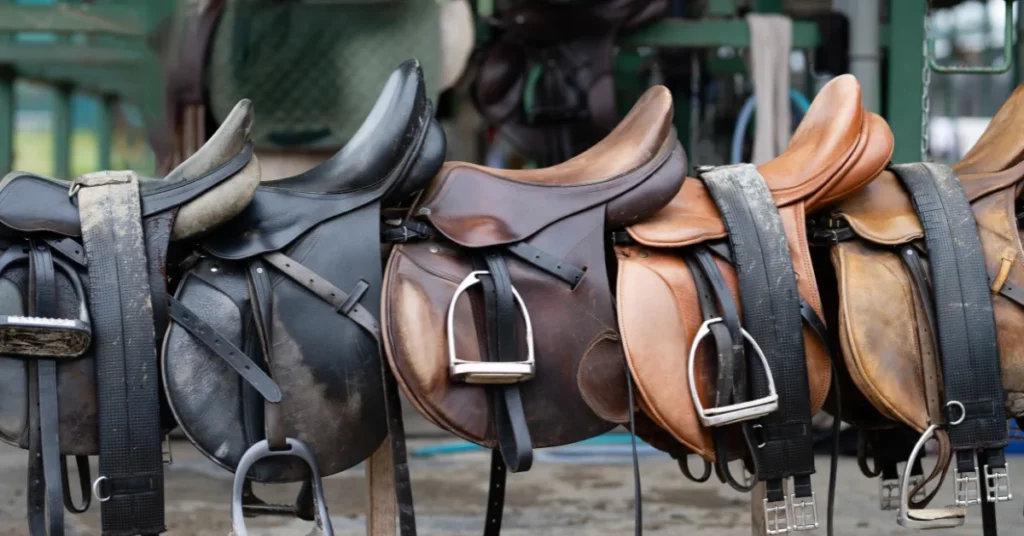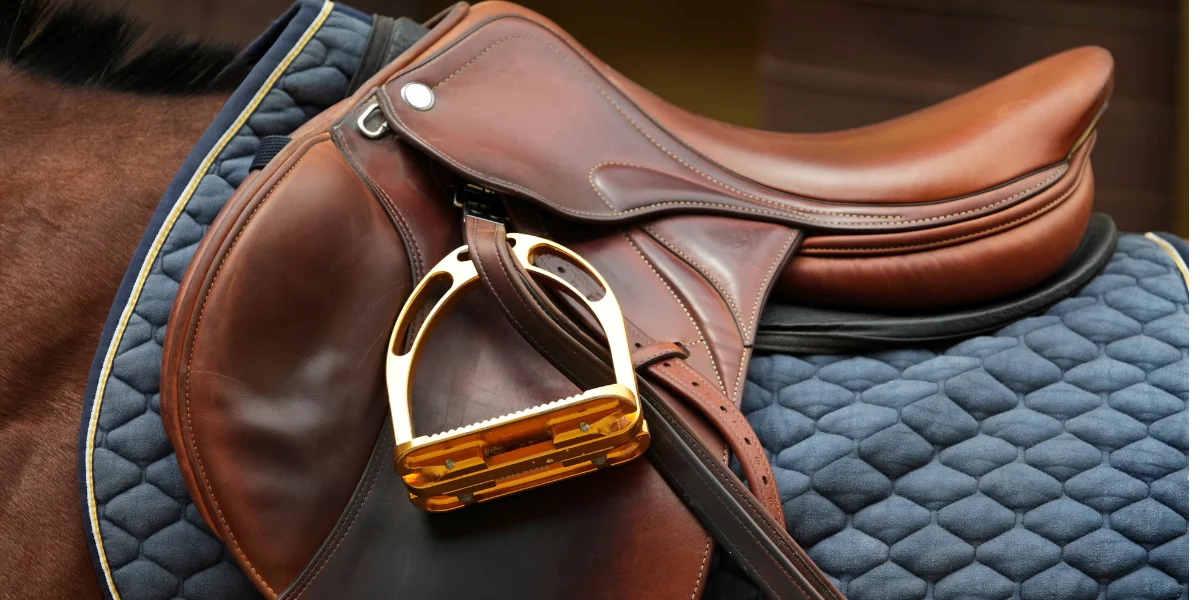If you love riding, you know that having the right saddle is important. Whether you have been riding for years or are just starting out, English saddles are designed for comfort, style, and control. Riders use them for many activities, like jumping, dressage, eventing, polo or casual riding. For hundreds of years, these saddles have helped both horses and riders perform their best.
In this blog, we’ll explore everything you need to know about English saddles—how they’re designed, their rich history, and how to choose the best one for your needs.

The History of English Saddles
English saddles have an exciting past that reflects how horseback riding has changed over time! They first appeared in Europe during the Middle Ages, designed for knights and noble riders who needed a secure and comfortable seat while riding into battle. These early saddles helped riders stay balanced and in control, making it easier to guide their horses.
As time went on, saddles evolved too. By the Renaissance, people began using English saddles for more than just war—they became popular for sport and leisure. Horseback riding became a sign of wealth and skill, and saddles were designed to be both stylish and practical.
In the 18th and 19th centuries, horse sports like show jumping, fox hunting, and dressage became more popular. Each of these activities required changes in saddle design, helping riders move better and giving horses more comfort. Over time, saddles were fine-tuned to match each specific sport.
The 20th century brought even more exciting changes. New materials and designs made English saddles lighter, stronger, and more comfortable. Even though technology has improved them, English saddles still hold onto their classic style and purpose, remaining a key part of horseback riding all over the world
English Saddles Explained: Types, Materials, and Styles
Breaking down the parts of an English saddle is like unraveling a practical piece of art. At its core, the saddle consists of several essential components, the tree, the seat, the panels, the girth, and the stirrups. The tree is the backbone, offering structure and durability, while the seat and panels are there to provide comfort and balance for the rider.
The choice between leather and synthetic materials is a big decision for many riders. Leather is known for its durability and classic look, offering a traditional feel and often a longer lifespan if properly cared for. On the other hand, synthetic saddles come with a whole different set of perks. They’re lighter, easier to maintain, and usually more affordable, making them a great choice for new riders or those on a budget.
When it comes to styles, English saddles are not one-size-fits-all. Depending on your equestrian passion, you might lean towards a Dressage saddle with its deep seat and long flaps for closer contact, a Jumping saddle with a shorter, more forward flap for greater agility, or perhaps an All-Purpose saddle that offers a good balance for those who dabble in various riding styles.
Choosing between leather and synthetic involves weighing pros and cons carefully. If you want a sleek, timeless look and don’t mind regular maintenance, leather could be your better option. But if low maintenance and a lighter saddle are more your speed, synthetic might be the way to go. Either way, it’s all about finding what suits your needs and riding style best.
English Saddles vs. Western Saddles
English and Western saddles each bring their own flair and functionality to the table, making them suited for different riding styles and disciplines. English saddles are generally lighter and smaller, designed to allow a closer connection between horse and rider. They focus on offering balance and agility, which is ideal for equestrian sports like jumping and dressage.
On the flip side, Western saddles are built for comfort and stability during long hours on the trail. They have a larger, heavier design with a horn in the front, providing extra security and a place to tie equipment. This makes them particularly popular in disciplines like trail riding, working cattle, and rodeo events.
Functionally, the choice between these two comes down to how and where you ride. English saddles offer great mobility and responsiveness, giving riders the precision needed for quick maneuvers and jumps. Meanwhile, Western saddles provide a more relaxed ride, which is perfect for spending long days in the saddle.
Beginners might wonder which saddle type is easier to start with. English saddles can demand more balance due to their lighter build, but they also teach the rider a more sensitive way to cue and communicate with the horse. Western saddles, being more stable, offer peace of mind and comfort, allowing new riders to focus on learning without stressing over balance.
Ultimately, the decision might boil down to personal preference and specific riding goals. Whether you lean towards the English saddle’s finesse or the Western model’s sturdiness, each has a unique role to play in the equestrian world.
The Perfect Fit: Sizing, Fitting, and the Second-hand Saddle Market
Getting the right fit for your English saddle is absolutely key to ensuring comfort for you and your horse. A well-fitted saddle supports better posture for the rider and prevents discomfort for the horse. It’s all about achieving balance, and it starts with knowing your horse’s back shape and size.
To check the fit of your saddle, place it on your horse without any pads initially. You should be able to fit about three fingers between the pommel and the withers. Check that the saddle sits level and doesn’t rock side to side. It’s crucial to ensure there’s even pressure along the horse’s back once the girth is tightened and the rider is mounted.
Now, the option of buying a used saddle can be an attractive one, especially considering the cost savings. Used saddles have the advantage of being well-broken-in and often more comfortable right from the start. However, make sure to inspect them thoroughly for any signs of wear or damage that could affect their safety or performance.
While second-hand saddles can be friendly to the budget, they require a careful eye to ensure they meet your needs and standards. A good condition used saddle can be a treasure, offering style and quality that’s stood the test of time, but it’s wise to consult with a saddle fitting professional if you’re unsure about your choice.
In the world of English saddles, finding the balance between fit, function, and finance is crucial. Whether buying new or second-hand, what matters most is that the saddle serves the horse and rider well, enhancing their experience and performance in the arena or on the trail.
Lets take a look at the different types of English saddles and their purposes:
Saddle Types
1. All-Purpose Saddle
Best For: Versatile riders, beginners, and casual riding.
An all-purpose saddle is designed to accommodate various riding disciplines, including jumping and flatwork. It features a moderately deep seat and slightly forward-cut flaps, making it a good choice for riders who engage in multiple activities without specializing in one discipline.
2. Dressage Saddle
Best For: Dressage riders, flatwork, and precision riding.
Dressage saddles have a deep seat and long, straight-cut flaps to allow for maximum leg contact and a correct dressage position. The design helps riders maintain proper posture and balance while performing intricate dressage movements.
3. Jumping Saddle
Best For: Show jumping, hunter/jumper competitions, and eventing.
Jumping saddles feature a flatter seat and forward-cut flaps that accommodate shorter stirrups, allowing riders to maintain a secure two-point position over fences. The knee and thigh rolls provide additional support during jumping.
4. Eventing Saddle (Cross-Country Saddle)
Best For: Eventing and cross-country riding.
This saddle is a hybrid between a jumping saddle and an all-purpose saddle. It has a slightly deeper seat for stability and forward-cut flaps to support a secure jumping position. Eventing saddles are built to handle varied terrain and long riding sessions.
5. Showing Saddle
Best For: Show riders and elegant presentation in competitions.
Showing saddles are designed for the show ring, often featuring a flatter seat and minimal padding to provide a sleek, elegant look that allows close contact between horse and rider. They are used in disciplines such as showing and equitation.
6. Endurance Saddle
Best For: Long-distance riding and endurance competitions.
Endurance saddles prioritize rider and horse comfort over long distances. They typically have a deep, cushioned seat and additional padding to distribute weight evenly, reducing strain during extended rides.
7. Polo Saddle
Best For: Polo players and fast-paced maneuverability.
Polo saddles are designed with a flat seat and minimal padding, allowing players to move freely and swing their mallets without restriction. The design also aids in quick turns and fast acceleration.
8. Racing Saddle
Best For: Thoroughbred racing and jockeys.
Racing saddles are extremely lightweight with a very flat seat and short stirrup leathers, allowing jockeys to adopt a crouched position over the horse’s withers. These saddles are designed for speed and minimal interference.
We’d love to hear from you! Have questions about English saddles? Want to share your favorite brands or riding experiences? Drop a comment below or explore more of our site for expert tips and recommendations. Don’t forget to sign up for updates so you never miss a new post!
Happy riding! 🐴✨

